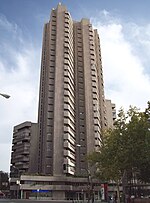Aguirre School

The Aguirre Schools (Spanish: Escuelas Aguirre) is a notable Neo-Mudéjar style building in Madrid Spain. Located at Calle de Alcalá, 62, it is named after Lucas Aguirre, a Spanish philanthropist who left funds for the construction of schools. As the building has housed the Casa Árabe e Instituto Internacional de Estudios Árabes y del Mundo Musulmán since 2006, it is also currently known as the Casa Árabe ("Arabic House"). This Neo-Mudéjar style building was designed by Emilio Rodríguez Ayuso and built from 1881-1886. The same architect later added an enclosure (1887) and garden (1896–98). Subsequently architect Luis Bellido González performed alterations in 1908–1909 and 1929, with a third set of alterations and basement extension made by Antonio Flórez Urdapilleta and Bernardo Giner de los Ríos in 1932–1933.
Excerpt from the Wikipedia article Aguirre School (License: CC BY-SA 3.0, Authors, Images).Aguirre School
Calle de Aguirre, Madrid Salamanca
Geographical coordinates (GPS) Address External links Nearby Places Show on map
Geographical coordinates (GPS)
| Latitude | Longitude |
|---|---|
| N 40.421666666667 ° | E -3.6816666666667 ° |
Address
Escuelas Aguirre (Casa Árabe)
Calle de Aguirre
28009 Madrid, Salamanca
Community of Madrid, Spain
Open on Google Maps










